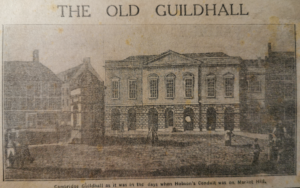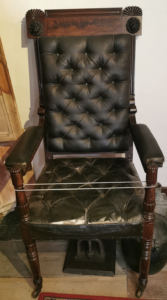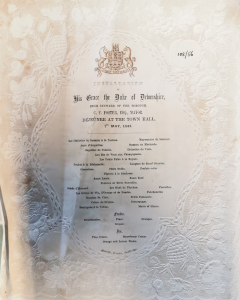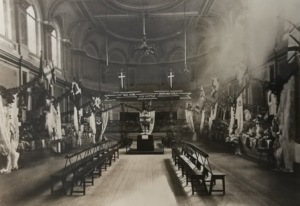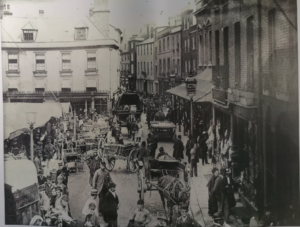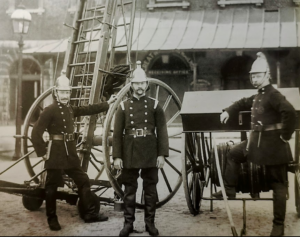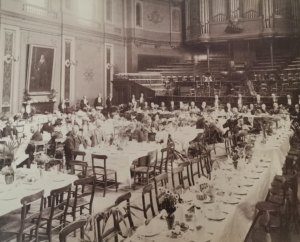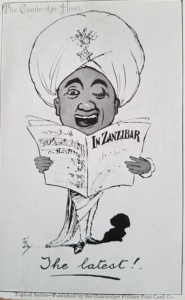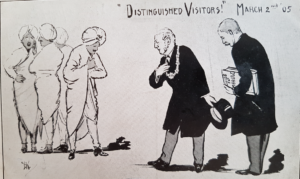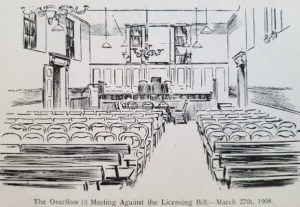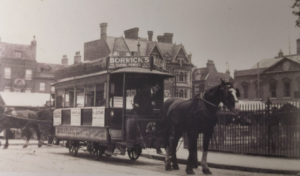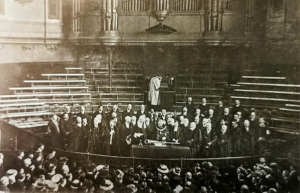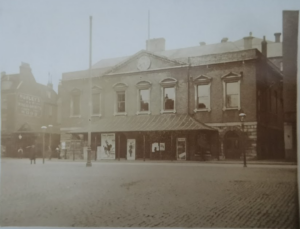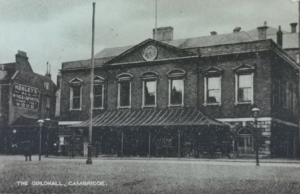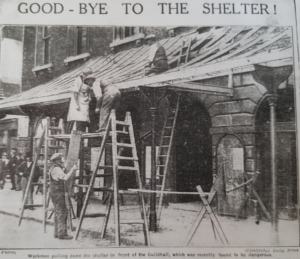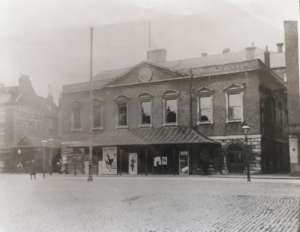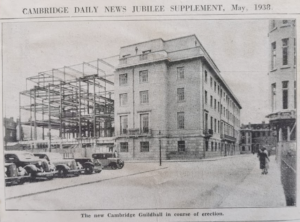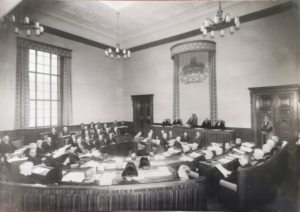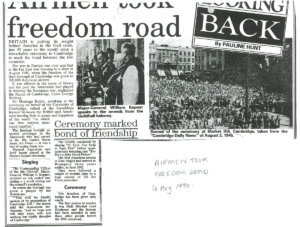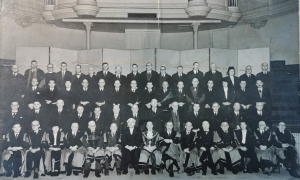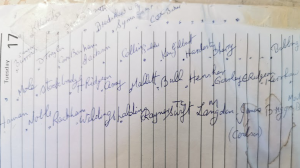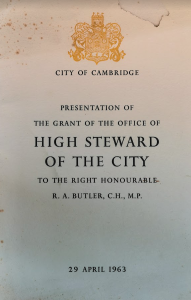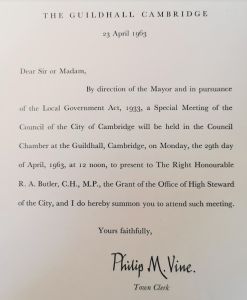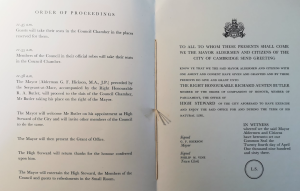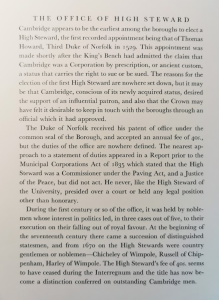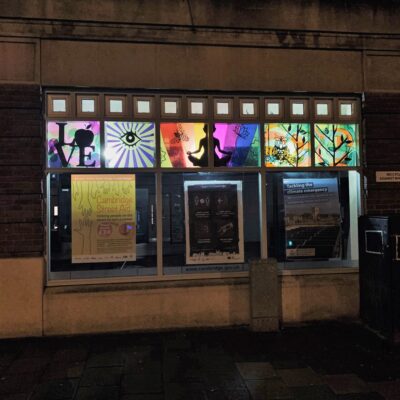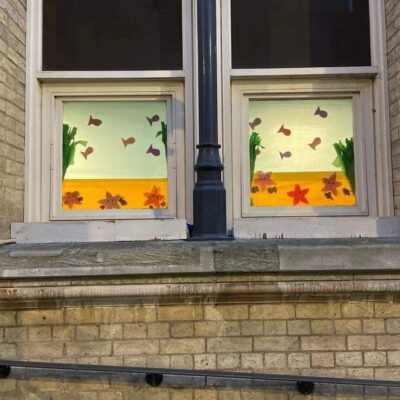Search by topic
- archaeology
- architecture
- bricklayer
- Building of Local Interest
- carpenter
- church
- crime
- dressmaker
- fire
- Great Eastern Railway
- listed building
- medieval
- oral history
- Public House
- Rattee & Kett
- Religious House
- Roman
- scholar
- school
- Then and Now
- tudor
- women
- work
- world war one
- world war two
Search by text
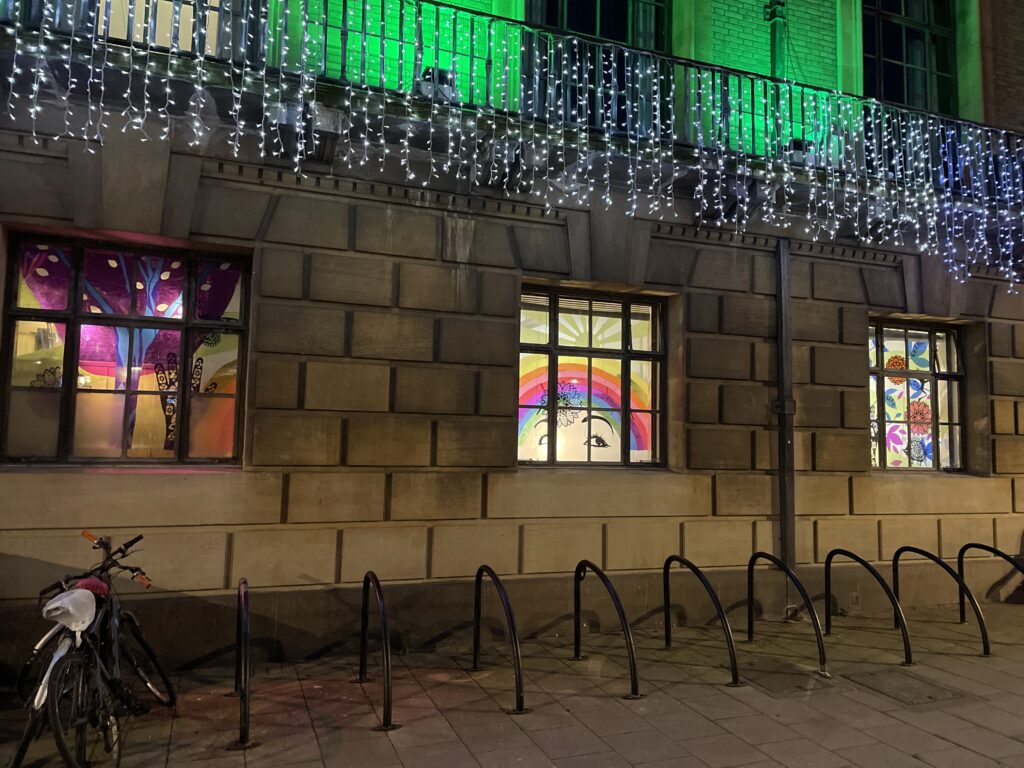 Windows decorated by Oblique Arts. Photos by Lewis Anderson.
Windows decorated by Oblique Arts. Photos by Lewis Anderson.Guildhall / Town Hall (Jew’s House / Synagogue / Gaol / Tollbooth)
History of the Guildhall Cambridge
The earliest buildings on the modern Guildhall site included two connected with the Jewish community.
See Enid Porter’s article: The Guildhall
Also F A Keynes, ‘By-ways of Cambridge History’, chapter 1, The Guildhall and the Market Place
The Cambridgealive web site notes:
1224 Henry II grants the burgesses of Cambridge possession of a house belonging to a Jew named Benjamin for use as a town gaol. The “Jew’s House” is sited in what is now the Guildhall site.
1270 The old synagogue, formerly a Franciscan monastery, becomes a toll booth for the market which is already in place on the market square site. The market thrives and develops over the next four centuries.
Alison Taylor in Cambridge The Hidden History p.89 notes:
The Jewish legacy of domestic buildings in stone was also the origin for the only significant public buildings other than churches to have a long and important history in Cambridge. The stone-built house of Benjamin the Jew was used as a gaol from 1224. The adjacent synagogue was given to the Franciscans who occupied it for about 50 years despite unhappy relations with their neighbours, until they acquired the site that was to become Sidney Susses. The synagogue then became the Town Hall, generally known as the Tollbooth as collection of market tolls was a major function. It served until 1374, being then replaced with a simple meeting room over open arches, where stalls were held. The gaol next door continued in use.
1386 The Guildhall or Tolbooth was rebuilt in 1386, and though it appears to have been diminutive in size and unpretending in its architecture, the building then erected continued in use for just four hundred years. Like almost all medieval Town Halls, it consisted of an upper storey supported on arches, the space below being open to the Market Place (T D Atkinson pp 81-94 in A Nelson, Early Cambridge Theatres 1994)
1488-9 Likewise as rewards given various persons playing in the commonhall 8d
2s as rewards given to the same earl’s [=Oxford’s] entertainers … in the guildhall
1530-1 Item payd for v players at the gyldehalle by the commaundement of Master Mayer iij s iiij d (Cambridge Town Treasurers’ records)
1547-8 Item to players at the hall by the comaundement of Master Mayer Mr Chapman & Mr Rust ij s [possibly for acting companies] (Cambridge Town Treasurers’ records)
1552 For ij brydalls [marriage feast] kept in the Gulyld halle, ij s (Cambridge Town Treasurers’ records)
The Queen’s Men, acting company, visited Cambridge with some regularity from 1561-2 and 1596-7 and must have played often in the Guildhall. (A H Nelson p.90)
1562 Item, of Thomas Clarke for a brydale kept in the hall, xx d (Cambridge Town Treasurers’ records)
1567-8 Item paid masen [= Mason] for plaienge at the guilde hall at the comaundement of master maier & the counsel xiij s iiij d [possibly for acting companies] (Cambridge Town Treasurers’ records)
1569-70 Item to Gibbons [William Gibbons, town piper and father of celebrated composer Orlando Gibbons] for playeinge at the hall vpon Hocktuisdaie xvj d (Cambridge Town Treasurers’ records)
1601 Queen Elizabeth gives the gaol from the town to the University. The townspeople object, and a court battle ensues.
1607 The court settles in favour of the townspeople, who are ordered by the judge to “enjoy the Jayle as they formerly have done”.
1611 Item to the town waytes … for musicke at the hall xvj d
1619 Item, to Ireland Mason for mendinge the witches gaole 10s 10d
This ‘witches gaole’ was just part of the ordinary felons’ quarters as shown by the entry in the Treasurers’ Accounts for 1620:
For amendinge the particion between the Witches gaole and the other fellons gaole.
1671 Samuel Newton’s Diary 30 Sep., describes the visit of King Charles II to Cambridge. The king was met on Christ’s College piece by the aldermen. There was later a dinner at the Town Hall at which were most of the knights and gentlemen of the county.
1747 Part of the market site is given up for the construction of an elegant new “Shire House”, of classical design.
1782 The old Town/Guild Hall is demolished and a new Guild Hall, designed by James Essex, is built on the site, at a cost of £2,500. The money is raised both by public subscription and the sale of titles for 30 guineas each. The new building has an Assembly Room, linked to the Shire Hall, an Aldermans’ Parlour, a Common Counsellors’ Parlour and Kitchen, with commercial premises (including a coffee house) on the ground floor.
Ada Keynes writes about the foundation stone from this time. Its position was lost until the Essex building was demolished to make room for the next Guildhall. The foundation stone from 1782 was then discovered in its original position, about 18 inches below floor level. It still had two small coins underneath, just as described in the volumes of Horace Walpole’s correspondence. William Cole had composed the inscription on the stone and he had written about this to Walpole. The stone is peculiar; it came from a quarry at Barnack and must have been much older than other stone used in the building. It has been thought that it might have been a threshold for a medieval doorway, or have been salvaged from the ruins of Barnwell priory.
1788 The Jew’s House’s use as a gaol ceases, the building now dilapidated. It is demolished, after at least 500 years, in 1800. This clears the area for private and commercial development, which was to go on to restrict development of the site by the Corporation until the 1930s.
The gaol was relocated to Downing Place and then in 1829 to Parker’s Pieces.
See Enid Porter’s article: Crime and Punishment
1802 In this year James Nield, a prison reformer who visited all the gaols in the country, wrote about the state of Cambridge Gaol as it had been. “There was formerly a room below for criminals called the Hole, 21 feet by 7, and above a room called the Cage. No court-yard, no water, no allowance [for food]. On my visit, August, 1800, I had the pleasure to find the Cage had fallen into the Hole, and both were a heap of ruins.” (F A Keynes, p 11)
The 1934-9 building by C Cowles-Voysey replaced the 1746-7 building by Sharman and Barratt. The foundation stone of the earlier building survives though embedded in the wall on the first floor of the E. wing. On it is the baton inscription ‘Faxit Deus haec nova Gilda Aula Communitatis Villae Cantabrigiae, in ipsissimo Loco ceteris jam periclitantis et ruinosae, posita‘, dated 1782.
There is a Wikipedia entry.
1821 Coronation of George IV: Cambridge Chronicle and Journal 20.7.1821:
The Coronation. Yesterday being the day appointed for the coronation our most gracious Sovereign, the auspicious event was commemorated in this place with a degree of splendour and solemnity, consonant to those feelings of loyalty for which its inhabitants have been long distinguished. The morning was ushered in by merry peals from the bells of various churches, and the shops being closed, afforded a general holiday to all descriptions of persons. At eleven o’clock, the Heads of Houses and other resident members of the university, as well as the Mayor and Corporation, with a considerable number of the inhabitants, attended divine service at St. Mary’s Church, where a most eloquent and appropriate sermon was preached in a very dignified and impressive manner, by the Rev. Dr. Wordsworth, Master of Trinity college and Vice- Chancellor, from the following text: “Behold, O God our shield, and look upon the face of thine anointed.” Psalm lxxxiv. 9. The sermon, which embraced the subject of the day in a most luminous and masterly manner, and was couched in language at once clear, powerful and energetic, appeared in strong unison with the feelings of the audience, and produced an effect which will not soon lose its influence upon one of the most numerous congregations which ever crowded this sacred edifice, —After the sermon, Handel’s Coronation Anthem was performed by the University Choir.
The day was observed throughout the university in the same manner as the appointed public festivals.
At four o’clock, upwards of 100 of the principal inhabitants sat down to a sumptuous and elegant dinner at the Town Hall, Sir J. C. Mortlock in the chair. After the cloth was drawn, the following loyal, constitutional and appropriate toasts were drank, and the afternoon was passed with the greatest harmony, conviviality, and good humour.
The King.—4 times 4.
The memory of George III.
The Duke of York, the Heir Presumptive to the Throne.
The Royal Family.
The British Constitution.
The Duke of Clarence and the Navy.
May the King defend our Laws, our Laws the People, and the People the King.
The Chairman.
The Duke of Wellington and the Army.
The Chancellor of the University.
The Lord Lieutenant of the County.
The High Steward of the Corporation.
The Vice-Chancellor and prosperity to the University.
Prosperity to the County.
Prosperity to the Town.
Members for the University, County, and Town.
The memory of Lord Nelson, Sir Ralph Abcrcromby, and the brave Officers, Sailors, and Soldiers, who fell in the brilliant engagements of tbe late war.
Tlie memory of our old friend Blucher.
The Land we live in, and the Fair we love.
The liberty of the press without its licentiousness.
The Champion of England, and may Englishmen ever prove Champions in defence of the King and Constitution.
Marquis of Anglesea.
Lord Exmouth.
May differences of opinion never interrupt the harmony of private life.
Several smaller parties assembled together on the happy occasion; and many tradesmen regaled the workmen and other persons their employ, in celebration of the day.— Dinners were also given the numerous servants of the various colleges.
We should be wanting in duty if we were to pass over in silence the readiness which has been everywhere shewn to convert the public feeling towards the benefit of the poor. Besides the general subscription made to this effect, in furtherance of the views of the committee at the Town-hall, private subscriptions were set on foot in all the parishes, many of which were collected personally by the respective ministers and churchwardens, towards providing public dinners and other donations for the poor. Every encouragement was given in the several colleges to this effect. The Master and Fellows of Jesus college, upon an application from the Minister of All Saints’ parish, granted not only the use of their cloisters for this purpose, but also allowed the use of the college kitchen for dressing the dinner, the servants being employed in setting forth the tables, benches, &c. The party went in procession, headed by their Minister, and accompanied by a band of musicians, from All Saints’ church to Jesus college. The band, composed entirely of volunteer performers, played during dinner in the midst of the grass-plot. As soon as the dinner was served, at which nearly 300 persons attended, the whole company stood up, and the the Minister of the parish said grace ; the parish-officers being stationed in different places to carve the meat, &c; afterwards the band struck up “God save the King,” and his Majesty’s health being drank, was hailed with three times three from all the company present.
A dinner on a similar plan was given in the parish of St. Andrew the Great, to about 500 persons. The tables were arranged near Downing college wall, and the dinner cooked at Emmanuel kitchen. In the parish of St. Sepulchre upwards of 300 persons were entertained in a similar manner. Dinners on smaller scale were given in several other parishes; and in the remainder, meat, bread and money were distributed. The regulations appeared to afford general satisfaction.
In the afternoon, the populace were amused by variety rustic sports on Parker’s Piece.
In the evening the town was generally illuminated. The front entrance of St. John’s college was rendered peculiarly splendid, profusion of lamps arranged in appropriate devices. The fronts of Trinity, Christ, Sidney and Emmanuel colleges were also distinguished by their brilliant appearance, and the other colleges were also lighted up in a very pleasing style.—The front of Great St. Mary’s church was ornamented by a magnificent crown in variegated lamps, and many the other churches and public buildings were also illuminated in a brilliant manner. The private houses were, in numerous instances unusually splendid; but the early hour at which we go to press prevents our giving a detailed account of the appropriate transparencies and elegant devices which were displayed.
1841
1846 2 March. Josiah Chater went with his brother and some of the Smart family to see the famous dwarf ‘General’ Tom Thumb. He paid a shilling for a ticket and enjoyed the show very much despite some noisy undergraduates.
Romilly in his diary entry for 7th March 1846 referred to a great town and gown row. This broke out on the 6th after a Tom Thumb show. It was more vicious than usual and the hard-pressed police resorted to measures so firm that one of them was dismissed and gaoled.
1846 30 Dec. Josiah Chater paid sixpence to see Waxwork Anatomical Models
1847 Josiah Chater heard Dr Grindrod speak on temperance.
1848 Josiah heard Dr Ross lecture on hydropathy.
1848 autumn: Isaac Pitman gave a talk on his newly-devised system of shorthand constructed on a phonetic basis. Josiah Chater attended the lecture and paid 5s for a course of instruction and 3d for a course book. Opinions of the method were mixed and Josiah found that the method got confused with a system he already knew. However, a ‘Society for Instruction in Phonography’ was formed.
1853 21 September. The first Cambridge YMCA Conversazione was held here. They took place in the evening and consisted of musical items, short lectures and refreshments.
1854 4th November: Romilly records in his diary: There was an intense row last night in the Townhall at the lecture of a paltry foolish man who ventured to declaim against smoking in its headquarters. Romilly’s editor notes: The would-be speaker, one Thomas Reynolds, founder of the British Anti-Tobacco Crusade and editor of the Anti-Tobacco Journal, was met by rowdiness of students with pipes and cigars. Two Johnians were afterwards fined for assault on the police who had helped the Mayor and Proctors to clear the place and the riot attracted much comment in the national press.
1854 13 December. Second Conversazione. Josiah Chater sent a report to the Cambridge Chronicle.
1856 Guildhall meeting on the subject of petty crime and young offenders:
1857 Josiah Chater had a lot to do with this year’s Conversazione.
4th December 1857: Romilly the diarist records: At 2 to the Senate House to hear Dr Livingston. His editor notes: The Chronicle of 5 December devoted a special supplement to Livingstone’s lecture on the following afternoon, where ‘the Town-hall never exhibited its wretched incapacity more strongly: only about a third of the people got in; as it was, gallery, platform and benches were crammed’. The Mayor warmly welcomed ‘ a gentleman whose explorations in Africa had resulted so beneficially in the advancement of civilisation and natural science.’
Cambridge residents denied the vote meet at the guildhall. 1859.
Oct 18th 1859: The diarist Romilly writes: In the Evening went to the Town Hall to hear Dickens read … The room was quite full and Dickens was received enthusiastically. I had never seen him before: he has great power of changing the expression of his countenance: I preferred him in the pathetic parts. he amused me by prefacing his reading with saying that he had no objection to the audience expressing the feelings which different parts of the reading might excite….. This performance lasted two hours.
Romilly’s editor adds: Romilly sensibly went to the second of Dicken’s two readings in Cambridge. The Chronicle of 22 October devoted three-quarters of a column to them and reported that on the first night hundreds of people were unable to get into the Town Hall…
1862
The Cambridge School of Art moved here from 9 Sidney Street. It remained here until 1909.
See: https://www.calh.org.uk/wp-content/uploads/2022/07/LLHRG-Bulletin-number-11.pdf
The opening of the large hall at The Cambridge Guildhall site, May 1862
1867 28 March. Charles Dickens reading at the Guildhall
1869 18 March. Charles Dickens reading from ‘Martin Chuzzlewit’ and ‘Holly Tree Inn’.
1871 census: (back of Guildhall – Town Arms[?])
John Manning, 65, widow, musician, b Hunts
Mary A, 28, housekeeper, b Cambridge
Louisa, 18, b Cambridge
1877 The Illustrated Police News 3/11/1877
DISGRACEFUL SCENES AMONGST UNDERGRADUATES AT CAMBRIDGE
This is a report about rioting during and after a performance by Dr Lynn at the Guildhall. The article doesn’t make it clear what Dr Lynn actually did!
1880
The shambles of Cambridge Borough Council’s deliberations on a new guildhall in the 1890s
At the beginning of the 20th century an annual ‘Our Sailors’ Grand Bazaar was being held at the Guildhall.
1901
1903
Stanley Buckmaster KC selected as the Liberal Candidate for Cambridge Borough – 1903
In 1905 two Trinity students, Horace de Vere Cole and Stephen created a hoax visit by the Sultan of Zanzibar to Cambridge. On 2nd May they were met at Cambridge by coach and taken to the Guildhall to meet the mayor who was only informed of the visit that morning. They had lunch and were taken on a tour of the town. This had similarities to the 1873 Shah of Persia hoax. (Horace de Vere Cole is also mentioned in A House By The River p.74 as prankster on the river who ran foul of Professor Darwin.)
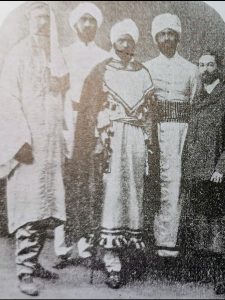
1905, Sultan of Zanzibar hoax: from left, Adrian Stephen, Bowen Colthurst, Horace Cole, Leland Buxton and “Drummer” Howard.
For more information see:
https://en.wikipedia.org/wiki/Dreadnought_hoax
and Enid Porter’s article:
1907
Keir Hardie MP faces down hordes of offensive Cambridge undergraduates. February 1907. (Part 1)
In 1908 the Guildhall was the venue for a protest meeting against the new Licensing Bill.
The Cambridge Independent Press (3.4.1908) reported that on 27th March a meeting was held at the Guildhall by local representatives of the “Trade” to put forward the motion: “That this meeting condemns the present Licensing Bill as in no way promoting Temperance, while the provision as to Time Limit confiscate Rights of Property acquired with the sanction of the State, and in reliance on the protection of the Law.”
The report went on to say that the audience was a large one but there was ample space in the main hall so the arrangements for an overflow audience in the small hall were superfluous. “Hardly one of the speakers applied himself to any serious argument, but adopted a sarcastic or humorous line, and really at times the speeches were very amusing.”
12/12/1912 When Mr’s Pankhurst arrived for a Suffragette meeting at the Guildhall the streets were impassable, 20 policemen were on duty at the entrance and the air was filled with the horrible stench of stink-bombs. Although the audience comprised a large opposition who created a good deal of uproar, the noise gradually diminished as her speech advanced and she was perfectly audible. Georgina Brackbenbury who took the chair had more interruption by the sound of a penny trumpet; its owner was a musician who produced notes mournful or joyous according to her words and achieved a flourishing Reveille. Afterwards crowds ringed a motor car waiting outside the Wheeler Street entrance, which had one of its tyres deflated. But Mrs Pankhurst was quietly conducted out by the Guildhall Street entrance and to the Lion Hotel. (Cam.News)
1913
How a ratepayers’ rebellion finally sank John Belcher’s magnificent guildhall plan. 1913.
1914
1915
Bishop of Ely says “Peace now would be a crime” – August 1915
1918
Sir Eric Geddes threatens to hang The Kaiser – Cambridge Guildhall December 1918
1920
“The field gun is too big – can we have a couple of trench mortars instead?”
12/3/1930 A crowd of nearly 3,000 massed in front of the loud speaker which Pye Radio had installed in the main window of the Cambridge Guildhall. Business in the market was suspended and the lanes between the stalls were solid with people. In the shops and offices there was a general cessation of work; counters and desks were forsaken and faces appeared at every window. There was a cheer when the Cambridge boat crew drew level and overtook Oxford. Workers hurrying home eagerly bought copies of the special edition of the CDN and pictures are being shown at the Central and Tivoli cinema this evening. (Cam.News)
25/2/1932 Apart from the large hall and council chamber the Cambridge Guildhall is worn out and absolutely unsuitable. The accommodation in every department was deplorable – dark, dismal, horrid, unlit and unhealthy. On Castle Hill there was a fine new building being erected for the County Council who were planning to spend £8,000 on furnishing alone. Never since the war had prices in the building trade been lower; this was the right moment to consider rebuilding, councillors were told. (Cam.News)
4/6/1932: A new Cambridge Guildhall should be built on the corner of East Road and Parkside where the site is three times as large, meeting the requirements of the Corporation for many years. The existing Guildhall on Market Hill should be replaced with shops on the ground floor and offices and flats above, councillors have recommended. (Cam.News)
15/7/1932 Cambridge councillors say the municipal buildings should remain on the Guildhall site and not move to Parkside as had been proposed. It should be a worthy building, not surrounded by shops. With four floors they could provide 70 per cent more accommodation for officials but five would add to the dignity of the building and leave some surplus space that could be let and provide a source of income. But it must not overwhelm the market place. (Cam.News)
11/8/1933 The veranda or shelter over the main entrance of the Guildhall was disgustingly dirty and unsafe and should be removed, the Surveyor reported. It had been built in 1878 and the public should get used to the Guildhall without it because it would not be incorporated in the new building. Others said it was a useful shelter and should be maintained at all costs: the Preservation Society would be shocked if they allowed that ancient piece of architecture to be scrapped. (Cam.News)
19/9/1933 Cambridge Guildhall dated back to about 1782 and there had been various extensions. In 1928 the Corporation bought shops in Peas Hill to allow for rebuilding. The possibility of providing shops on the ground floor had been considered but this would not allow sufficient offices for the extra staff needed to cope with their increased duties, an Inquiry was told (Cam.News)
13/3/1935 A packed public meeting at Cambridge Guildhall voted against plans for a new building and called on the council to remodel the front to a more dignified style of architecture. Cambridge was a treasure house of architectural gems and they had no right to hand down to posterity a freak building, a flat and uninteresting example of early 20 th -century abominations. Another motion dealing with the question of shops on the Peas Hill side of the building received scant attention as most of the audience had left before the end. (Cam.News)
10/4/1935 Demolition work on Peas Hill for the new Guildhall has led to an architectural discovery of outstanding interest. It has revealed the residence and business premises of a well-to-do Tudor merchant which was subsequently divided up into a detached and two semi-detached houses. The magnificent front was covered up with lath and plaster in the reign of Queen Anne and finished with mock bricks. Dummy eaves were also added. Now each piece has been carefully taken down and numbered for preservation and re -erection. (Cam.News)
1/5/1935 The Guildhall Protest Committee criticised plans for a useless portico of a most ornate and incongruous style which could be ‘put on cold’ in from of the proposed facade of the new Guildhall in two years’ time if the town really wanted it. They maintained the main entrance should be on Market Hill. It would allow a terrace which would form a platform for addressing meetings on Market Hill and give a facade of distinction that the people strongly desire. There was also intense feeling regarding the question of shops on the Peas Hill side (Cam.News)
7/1/1938: The demolition of parts of the old Guildhall has meant that several annual functions have lost their normal home. But a Mayoral reception elsewhere than in the Guildhall must surely be unique in Cambridge history. It is symbolic of the happy relations existing between the Town and the University that the Old Schools should have been placed at the disposal of the councillors. Cars containing guests pulled up on King’s Parade and a lengthy walk under illuminated awnings led to the Dome Room. The Council Room, East Room, Syndicate Room and Regent House were in use but only the dais where the orchestra played for dancing was decorated (Cam.News)
14/1/1938 The old Shire Hall on Cambridge Market Hill, was erected in 1747. At that a time the 14th-century Guildhall which stood on the south of Butter Row was under repair. This was pulled down in 1782 to be replaced by the Guildhall built by James Essex. Now demolition has revealed a fragment of the medieval Guildhall. Two pieces of ancient oak carved with leaves are thought to date from 1386. They will be replaced in the new building (Cam.News)
24/6/1938 The new Cambridge Guildhall basement could be regarded as splinter-proof and it would not be difficult to render it gas-resisting, the Air Raid Precautions Committee heard. If not done they could be criticised for allowing a public building without adequate protection and could not ask other stores or factories to comply with such regulations. But it would need to have 25 feet of concrete, with earth on top, to make it bomb-proof. It was absolutely and entirely impossible. (Cam.News)
22/7/1939 The new Cambridge Guildhall will be opened on October 9 th by the Earl of Derby. The grand staircase is much more imposing than the old one, the new small room, complete with carpet, will be very convenient and the large hall improved though it is not nearly large enough for conferences, political mass meetings or big musical enterprises. The new Council chamber also seems on the small side and the aldermanic bench has been considerably shortened. (Cam.News)
28/7/1939 Cambridge Town council held its last meeting at Shire Hall while the Guildhall was reconstructed.The Library committee asked to use the Small Room as temporary reading room during the rearrangement of the Central Library. But it had a very expensive carpet that might get spoilt. The library might use the Corn Exchange annexe if the cycles were moved. Aid Briggs said that was not a proper alternative: “The fact is that we have had made a beautiful Guildhall, but must not use it”. The carpet could be taken up. But the Guildhall might not be finished by that time and it would be unfortunate if people were allowed in the Small Room before the rest were completed. The request was denied (Cam.News)
1939-1945
Cambridge HQ HG Group/Zone Commander (5, 6 & 7 Bns.)
1945 (August):
Freedom of the City bestowed on 8th United States Army Air Force
30/9/1946: The Honorary Freedom of the Borough was bestowed on the Cambridgeshire Regiment in recognition of its service in the South African War, for its superb professionalism during the fighting in Flanders and for its valiant fight in the Far East. That fight had not ended with the last shots fired in the defence of Singapore – in fact the courage that was now being recognised was the 3 and a half years of captivity that followed. In prison camps scattered all over the Far East they had suffered every hardship, lack of food, disease, cruelty, indignities and utter isolation. Among many ordeals the building of the railway in the grim jungles of Siam was singled out by the Mayor for especial mention. The full extent of their sufferings was being to be revealed. Padre J.N. Duckworth told the inspiring spirit and morale under the most terrible conditions. In August 1944 he had been in the “valley of the shadow of death”, 450 miles long through which they were constructing the Burma- Thailand railway, his audience were horrified to hear of the conditions and of the state of the men suffering ulcers, malaria, beri beri and dysentery. It had been August 13th 1945 when his particular camp had heard on their small Japanese radio of the atom bomb dropped on Hiroshima, four days later it was over – “there was no flag waving or anything like that, just a long sigh of relief”. Now there was flag waving – and a particular flag had place of honour from the Guildhall flagpole – the blue flag of the 1st Battalion of the Cambridgeshire Regiment that had somehow been kept hidden from their captives during the long years of captivity. As the procession wended its way down Petty Cury it was the drums that marked their progress. And amongst the drums were some emblazoned with the Regiment’s honours won in earlier wars but lost in the fall of Singapore. Amazingly they had been found by a Dullingham girl, Mary Taylor during her work with the Red Cross and shipped back to Cambridge. In October 1946 they led the old men of the First War and prematurely old boys from the Second to the Guildhall to receive the Freedom they had fought to preserve. (Cam.News)
1963
More information about the Guildhall as a theatre can be found:
http://www.arthurlloyd.co.uk/CambridgeTheatres.htm
For information on plans for the Guildhall that were never realised:
2021
Here is a link to the event page online for information about the event:
https://www.windowwanderland.com/event/cambridge-2021/
Contribute
Do you have any information about the people or places in this article? If so, then please let us know using the Contact page or by emailing capturingcambridge@
License
This work is licensed under CC BY-NC-SA 4.0








